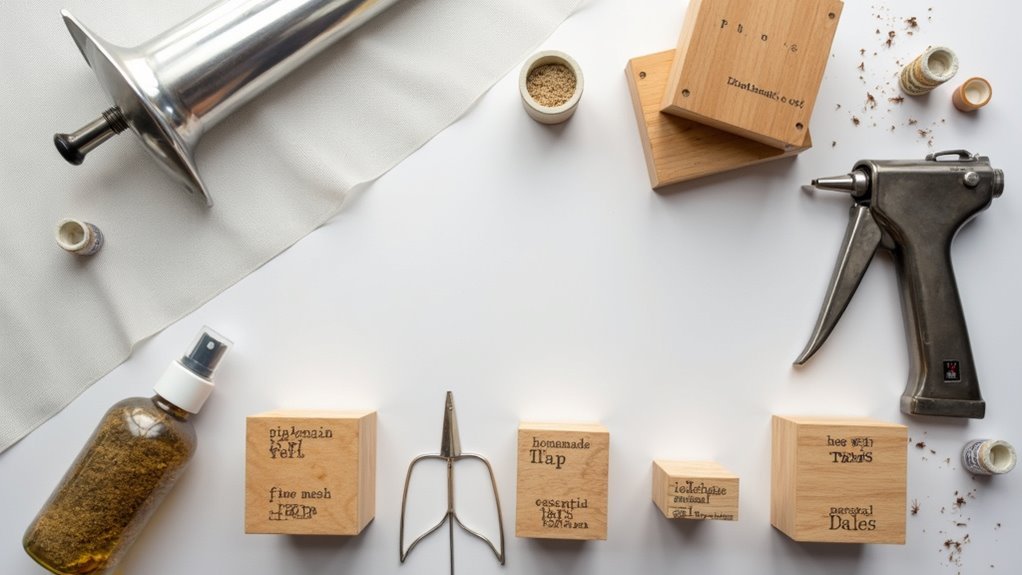You’ll protect your home effectively by sealing entry points with caulk and steel wool, eliminating moisture sources through proper drainage and dehumidifiers, storing food in airtight containers, and maintaining clean kitchens. Trim vegetation 12 inches from your foundation, remove outdoor debris, install weather stripping on doors, and use natural repellents like peppermint oil. Set strategic traps along walls and monitor crawl spaces regularly to keep humidity below 40%. These all-encompassing techniques will transform your home into a pest-resistant fortress.
Inspect and Seal Entry Points Around Your Home

While pests can enter your home through surprisingly small openings, you can effectively block their access by conducting a thorough inspection of your property’s exterior.
Start by examining all windows, doors, and foundation areas for cracks, gaps, and holes. Use the pencil test—if a pencil fits through an opening, mice can squeeze through too.
Seal small gaps with acrylic latex caulk for quick fixes. For larger entry points, combine steel wool or copper mesh with expanding foam to create effective barriers that pests can’t chew through.
Don’t forget to inspect door sweeps on exterior doors and replace worn ones. Regular inspections help you identify new entry points before they become major problems.
Eliminate Moisture Sources and Improve Drainage
Since moisture attracts countless household pests, controlling water sources around your home serves as one of your most effective defense strategies.
Start by regularly inspecting and repairing leaky pipes and faucets, as even small drips create ideal moisture conditions for cockroaches and ants. Establish proper drainage around your foundation by grading your yard to direct water away and installing functional gutters to prevent standing water accumulation.
Use a dehumidifier in basements or crawl spaces to maintain humidity below 50%, which helps eliminate pests like spiders and silverfish.
Keep mulch at least 12 inches from your foundation and turn it periodically to prevent moisture buildup. Clean and maintain your gutters regularly to avoid water buildup that creates breeding grounds.
These pest control solutions effectively prevent pests from establishing themselves in your home.
Maintain Proper Food Storage and Kitchen Cleanliness

Beyond controlling moisture, your kitchen practices play an equally important role in deterring household pests. Proper food storage and kitchen cleanliness create an environment that’s unwelcoming to unwanted visitors.
Implement these essential strategies to protect your home:
- Store cereals, grains, and pet food in airtight containers to prevent pest access and maintain freshness.
- Wipe down countertops and sweep floors daily to eliminate food crumbs and spills.
- Use garbage cans with locking lids and empty them frequently to minimize odors.
- Check pantry items regularly and dispose of expired products promptly.
Additionally, refrigerate perishables instead of leaving them on counters. This simple practice reduces fruit fly attraction and other pest problems.
Consistent kitchen cleanliness paired with strategic storage creates a powerful defense against household infestations.
Trim Vegetation and Remove Outdoor Debris
Your home’s exterior landscape directly influences pest activity around your property. Keep vegetation trimmed back at least 12 inches from your foundation to eliminate pest access points and improve airflow.
Remove piles of leaves, wood debris, and yard waste that create harborage sites for rodents and insects. Properly dispose of old automobiles, trash containers, and other large items that provide nesting opportunities.
Store firewood elevated off the ground in sealed containers rather than leaving it scattered.
Focus on maintaining effective drainage systems by clearing gutters and installing gravel barriers around your foundation. Standing water attracts mosquitoes and other pests, so guarantee proper yard drainage.
These exterior maintenance practices create an inhospitable environment for pests while protecting your home’s perimeter from unwanted invaders.
Install Weather Stripping and Door Sweeps

While exterior maintenance forms your first line of defense, sealing entry points around doors and windows creates an equally important barrier against unwanted invaders.
Weather stripping and door sweeps effectively block gaps that pests exploit to access your home’s warmth and food sources.
Focus on these essential pest-proofing steps:
- Install weather stripping around door and window frames to create tight seals that prevent small insects and rodents from entering
- Add door sweeps to exterior doors, blocking the common gap at the bottom where ants and mice frequently enter
- Test your seal effectiveness by checking for light or air leakage around closed doors and windows
- Inspect and replace worn weather stripping regularly to maintain prime protection
These simple installations considerably reduce pest infestations by eliminating primary access routes into your home.
Use Natural Repellents and Essential Oil Solutions
You can create powerful pest deterrents using simple essential oil spray recipes that target specific insects and rodents.
These plant-based solutions offer a safe alternative to chemical pesticides while effectively repelling ants, spiders, mosquitoes, and other unwanted visitors.
Essential Oil Spray Recipes
When it comes to creating effective natural repellents, essential oil sprays offer a powerful yet safe alternative to harsh chemical treatments.
You’ll find these homemade solutions provide excellent pest control while maintaining a non-toxic environment for your family.
Here are proven essential oil spray recipes you can make at home:
- Spider and mosquito deterrent: Mix peppermint oil, tea tree, or eucalyptus oil with water and spray around entry points.
- Homemade fly deterrent: Combine lavender or citronella oil with water for misting fly-prone areas.
- Ant prevention spray: Create an effective cleaning solution using equal parts vinegar and water to disrupt scent trails.
- Rodent repellent: Soak cotton balls in peppermint oil and place strategically in attics and basements.
These safe and non-toxic solutions effectively protect your home naturally.
Plant-Based Pest Deterrents
Beyond essential oil sprays, living plants themselves serve as powerful natural pest deterrents that work around the clock to protect your home.
You’ll find that planting herbs like basil and rosemary in your garden creates an effective barrier against flies, beetles, and mosquitoes through their strong natural scents.
Spearmint works particularly well as a versatile plant-based solution, repelling beetles and fleas whether you grow it outdoors or in indoor pots.
Don’t overlook citrus peels and coffee grounds as additional natural deterrents.
You can scatter citrus peels around entry points to repel ants and flies, while coffee grounds effectively keep snails and slugs away.
These plant-based pest management strategies complement essential oils perfectly, creating multiple layers of natural protection throughout your property.
Set Strategic Traps for Rodents and Insects
Although sealing entry points forms your first line of defense, strategic trap placement creates an essential secondary barrier that actively reduces existing pest populations while monitoring for new intruders.
Strategic trap placement serves as your crucial second line of defense, actively eliminating current pest populations while detecting new infiltrations.
When you set strategic traps for rodents, position snap traps along walls using effective baits like peanut butter or chocolate syrup. Place sticky traps where you’ve spotted insect activity to monitor pest populations effectively.
Consider these proven trapping methods:
- Position snap traps in dark corners with peanut butter bait for maximum rodent capture
- Deploy sticky traps near visible insect trails to reduce infestations quickly
- Create DIY fruit fly traps using apple cider vinegar mixed with dish soap
- Install pheromone traps targeting specific pests like moths or cockroaches
Remember to check and replace traps regularly to maintain their effectiveness.
Apply Caulk and Steel Wool to Foundation Gaps
Examine your home’s foundation carefully with a pencil as your measuring tool—if the pencil fits through any crack or gap, you’ve found a potential highway for mice and other unwanted visitors.
Anything wider than 1/4 inch becomes a pest entry point that needs immediate attention.
Apply caulk using acrylic latex for smaller gaps and cracks, smoothing it thoroughly for effective adhesion. This creates a tight seal that blocks pest infiltration.
For larger openings, stuff steel wool into the spaces first—its sharp edges deter rodents from chewing through.
Your pest-proofing efforts require ongoing maintenance since weathering and foundation shifting create new vulnerabilities.
Combine these sealing methods with hardware cloth or foam for thorough protection, checking your foundation regularly to maintain an impenetrable barrier against unwanted guests.
Keep Basements and Crawl Spaces Dry
Moisture creates an irresistible invitation for pests, making your basement and crawl spaces prime real estate for unwanted invaders.
Damp basements and crawl spaces become luxury hotels for pests seeking the perfect humid hideaway.
You’ll need to control humidity and moisture to keep pests away and maintain a home pest-free environment.
Here’s how to make these areas less inviting:
- Install proper ventilation or use a dehumidifier to maintain humidity below 40%
- Inspect and repair pipe or wall leaks immediately, as minor moisture attracts pests
- Apply polyethylene sheeting as a moisture barrier on crawl space floors
- Clean gutters regularly and direct downspouts away from your foundation
These moisture control strategies prevent water accumulation that draws spiders, insects, and other unwanted guests.
Monitor and Maintain Your Pest-Proofing Efforts
Since pest-proofing isn’t a one-time fix, you’ll need to establish a routine monitoring system to maintain your home’s defenses.
Schedule seasonal inspections every three months to inspect your home for new cracks, gaps, or openings that create fresh entry points. Take a proactive approach by documenting your findings during each inspection, which helps track pest activity patterns and recurring issues.
Keep your environment clean and clutter-free through regular maintenance, making it easier to spot early infestation signs.
Don’t forget to monitor moisture levels, especially in basements and crawlspaces, ensuring humidity stays below 40%. This ongoing vigilance prevents small problems from becoming major infestations and maintains your pest-proofing investments.
Frequently Asked Questions
How Can I Do Pest Control at Home by Myself?
You’ll need to seal cracks with caulk, clean surfaces regularly, store food in airtight containers, use natural deterrents like vinegar or essential oils, set traps, and inspect your home frequently for signs.
How Do I Bug Proof My House?
You’ll need to seal cracks with caulk or steel wool, store food in airtight containers, eliminate moisture sources, keep surfaces clean, trim vegetation away from your home’s exterior, and use natural deterrents like peppermint oil.
How Do I Spray My House for Bugs Like a Professional?
You’ll need professional-grade insecticide and proper equipment. Clean thoroughly first, then spray systematically around your home’s perimeter, entry points, and problem areas. Let it dry completely before re-entering treated spaces.
How to Prevent Pests in Home Naturally?
You’ll prevent pests naturally by using essential oil sprays, wiping surfaces with vinegar solution, sprinkling diatomaceous earth at entry points, planting repellent herbs, and sealing cracks with caulk.
In Summary
You’ve got the tools to transform your home into a pest-free fortress. By consistently applying these ten techniques, you’ll create multiple barriers that keep unwanted visitors out. Don’t wait for an infestation to start—begin implementing these strategies today. Stay vigilant with regular inspections and maintenance, and you’ll save yourself time, money, and frustration down the road. Your proactive approach will pay off with a comfortable, pest-free living environment.





Leave a Reply